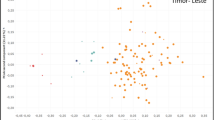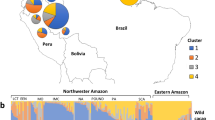Abstract
Carrot (Daucus carota L.) is a member of the Apiaceae family that includes economically important medicinal, ornamentals, seed spices and vegetables. However, the genomic resources in these crops are limited compared to carrot, which is enriched with a number of molecular markers that are publicly available. Hence, we studied the usefulness of the 30 carrot molecular markers for eight different genera composed of five seed spices/condiments and three vegetables. The study revealed the transferability of these carrot markers and the genetic diversity across the genera for respective loci were compared by phylogenetic assessment using an un-rooted neighbour joining tree (NJ) and principle coordinate analysis (PCoA). An average of 66.66% amplification with a total of 73 alleles from 30 loci was observed across eight crops with an average of 3.39 alleles/loci. The average polymorphic information content was 0.50, the effective number of alleles was 2.92, gene diversity was 0.56 with a highest fixation index of 0.82 observed among 18 polymorphic markers. These results indicate the practical use of these markers in the respective crops. Interestingly, phylogenetic analysis grouped the eight crops into three clusters, but the PCoA identified four groups in which carrot was out grouped and kept the other cluster composition intact. Comprehensive study of these eight crops with many more molecular markers would help to understand the evolutionary relatedness for distant hybridization among Apiaceae family members to either transfer genes of interest or to create novel crops.




Similar content being viewed by others
References
Barbará T, Palma-Silva C, Paggi GM, Bered F, Fay MFC, Lexer C (2007) Cross-species transfer of nuclear microsatellite markers: potential and limitations. Mol Ecol 16:3759–3767
Briard M, Le Clerc V, Grzebelus D, Senalik DA, Simon PW (2000) Modified protocols for rapid carrot genomic DNA extraction and AFLP™ analysis using silver stain or radioisotopes. Plant Mol Biol Rep 18:235–241
Cavagnaro PF, Chung S, Szklarczyk M, Grzebelus D, Senalik D, Atkins AE (2009) Characterization of a deep-coverage Carrot (Daucus carota L.) BAC library and initial analysis of BAC-end sequences. Mol Genet Genome 281:273–288
Cavagnaro PF, Chung SM, Manin S, Yildiz M, Ali A, Alessandro MS, Iorizzo M, Senalik DA, Simon PW (2011) Microsatellite isolation and marker development in carrot - genomic distribution, linkage mapping, genetic diversity analysis and marker transferability across Apiaceae. BMC Genom 12:386
Chistiakov DA, Hellemans B, Volckaert FAM (2006) Microsatellites and their genomic distribution, evolution, function and applications: a review with special reference to fish genetics. Aquaculture 255:1–29
Christine MK, John AM (2008) The role of herbs and spices in cancer prevention. J Nutr Biochem 19:347–361
Chun HS, Mansor CM, Chee YC, Idris S (2005) Transferability of SSR markers from lychee (Litchi chinensis Sonn.) to pulasan (Nepheliumram boutan-ake L.). Fruits 60:379–385
Dayanandan S, Bawa KS, Kesseli R (1997) Conservation of microsatellites among tropical trees (Leguminosae). Am J Bot 84:1658–1663
DeWoody JA, Avise JC (2000) Microsatellite variation in marine, freshwater and anadromous fishes compared with other animals. Indian J Fish Biol 56:461–473
Dirlewanger E, Cosson P, Tavaud M, Aranzana MJ, Poizat C, Zanetto A, Arus P, Laigret F (2002) Development of microsatellite markers in peach Prunus persica L. Batsch and their use in genetic diversity analysis in peach and sweet cherry (Prunu savium L.). Theor Appl Genet 105:127–138
Dirlewanger E, Graziano E, Joobeur T, Garriga-Calderé F, Cosson P, Howad W, Arús P (2004) Comparative mapping and marker assisted selection in Rosaceae fruit crops. Proc Natl Acad Sci 101:9891–9896
Ekué MRM, Oliver G, Reiner F (2009) Transferability of simple sequence repeat (SSR) markers developed in Litchi chinensis to Blighia sapida (Sapindaceae.). Plant Mol Biol Rep 27:570–574
Fan L, Zhang MY, Liu ZQ, Li T, Song Y, Wang LF, Zhang SL, Wu J (2013) Transferability of newly developed pear SSR markers to other rosaceae species. Plant Mol Biol Rep 231:1271–1282
Hernandez P, Dorad G, Martini A (2001) Cross-species amplification of the Hordeum chilense genome using barley sequence-tagged-sites (STSs). Hereditas 135:243–246
Iorizzo M, Shelby E, Douglas S, Zeng P, Pimchanok S, Jiaying H, Bowman M, Marina I, Walter S, Cavagnaro P, Yildiz A, Moranska E, Grzebelus E, Grzebelus D, Ashrafi H, Zhijun Z, Shifeng C, Spooner D, Van Allen D, Simon P (2016) A high-quality carrot genome assembly provides new insights into carotenoid accumulation and asteroid genome evolution. Nat Genet 48:657–666
Kalia RK, Rai MK, Kalia S, Singh R, Dhawan AK (2011) SSRs are small stretches of DNA, which has got small tandem repeat motifs for which primer pairs are designed for the flanking regions. Euphytica 177:309–334
Kawahara R, Sunabori S, Fukuda H, Komamine A (1992) A gene expressed preferentially in the globular stage of somatic embryogenesis encodes elongation-factor 1 alpha in carrot. Eur J Biochem 209:157–162
Kejun LS, Muse V (2005) Power Marker: an integrated analysis environment for genetic marker analysis. Bioinformatics 21:2128–2129
Kuleung C, Baenziger PS, Dweikat I (2004) Transferability of SSR markers among wheat, rye, and triticale. Theor Appl Genet 108:1147–1150
Kumar S, Mahendi HA, Fougat RS, Sakure AA, Jigar GM (2014) Transferability of carrot (Daucus carota) microsatellite markers to cumin (Cuminum cyminum). Int J Seed Spices 4:88–90
Matsuoka Y, Mitchell SE, Kresovich S, Goodman M, Doebley J (2002) Microsatellites in Zea—variability, patterns of mutations, and use for evolutionary studies. Theor Appl Genet 104:436–450
Mourad M, Jordi GM, Jean-Marc A, Pere A (2010) Prunus microsatellite marker transferability across rosaceous crops. Tree Genet Genomes 6:689–700
Niemann M (2001) Entwicklung von Mikrosatelliten – Marker bei der Möhre (Daucus carota L.) und die Marker ungeines Alternaria-Resistenzgens. Berichteaus der Agrarwissenschaft. Shaker Verlag, Aachen
Parthiban KT, Kumar RS, Thiyagarajan P, Subbulakshmi V, Vennila S, Rao MG (2009) Hybrid progenies in Jatropha—a new development. Curr Sci 96:815–823
Peakall R, Gilmore S, Keys W, Morgante M, Rafalski A (1998) Cross-species amplification of soybean (Glycine max) simple sequence repeats (SSRs) within the genus and other legume genera: implications for the transferability of SSRs in plants. Mol Biol Evol 15:1275–1287
Perrier X, Jacquemoud-Collet JP (2006) DARwin software. http://darwin.cirad.fr/darwin. Accessed 22 April 2017
Plieske J, Struss D (2001) Microsatellite markers for genome analysis in Brassica . I. development in Brassica napus and abundance in Brassicaceae species. Theor Appl Genet 102:689–694
Rai MK, Phulwaria M, Shekhawat NS (2013) Transferability of simple sequence repeat (SSR) markers developed in guava (Psidium guajava L.) to four Myrtaceae species. Mol Biol Rep 40:5067–5071
Ramaswamy K, Subash CG, Ji HK, Simone R, Bharat BA (2011) Neuro protection by spice-derived nutraceuticals: you are what you eat! Mol Neurobiol 44:142–159
Rathore SS, Saxena N, Balraj S (2013) Potential health benefits of major seed spices. Int J Seed Spices 3:1–12
Rod P, Peter SM (2012) GenAlEx 6.5: genetic analysis in excel. Population genetic software for teaching and research—an update. Bioinformatics 28:2537–2539
Rosetto M (2001) Sourcing of SSR markers from related plant species. In: Henry RJ (ed) Plant genotyping: The DNA fingereprinting of plants. CAB International, UK, pp 211–224
Rossetto M, McNally J, Henry RJ (2002) Evaluating the potential of SSR: flanking regions for examining taxonomic relationships in the Vitaceae. Theor Appl Genet 104:61–66
Saghai Maroof MA, Biyashev RM, Yang GP, Zhang Q, Allard RW (1994) Extraordinarily polymorphic microsatellite DNA in barley: species diversity, chromosomal locations, and population dynamics. Proc Natl Acad Sci USA 91:5466–5470
Saha MC, Cooper JD, Rouf-Mian MA, Chekhovskiy K, May GD (2006) Tall fescue genomic SSR markers: development and transferability across multiple grass species. Theor Appl Genet 113:1449–1458
Sarvamangala C, Gowda MVC, Varshney RK (2011) Identification of quantitative trait loci for protein content, oil content and oil quality for groundnut (Arachis hypogaea L.). Field Crops Res 122:49–59
Soufflet-Freslon Matthieu J, Jeremy C, Sebastien H, Mathilde B, Didier P, Emmanuel G (2013) Functional gene polymorphism to reveal species history: the case of the CRTISO gene in cultivated carrot. PLoS ONE 8:e70801
Squirrell J, Hollingsworth PM, Woodhead M, Russell J, Lowe AJ, Gibby M, Powell W (2003) How much effort is required to isolate nuclear microsatellites from plants? Mol Ecol 12:1339–1348
Tabbasam N, Zafar Y, Rahman M (2014) Pros and cons of using genomic SSRs and EST-SSRs for resolving phylogeny of the genus Gossypium. Plant Syst Evol 300:559–575
Toni G, Eugene VK (2013) Functional and evolutionary implications of gene orthology. Nat Rev Genet 14:360–366
Varshney RK, Graner A, Sorrells ME (2005) Genic microsatellite markers in plants: features and applications. Trends Biotechnol 23:48–55
Weising K, Nybom H, Wolff K, Kahl G (2005) DNA fingerprinting in plants: principles, methods and applications, 2nd edn. CRC Press, Boca Raton
www.nhb.gov.in. Accessed 14 Sept 2017
Zucchi MI, Brondani RPV, Pinheiro BJ, Brondani AC, Vencovsky ÀR (2002) Transferability of microsatellite markers from Eucalyptus spp to Eugenia dysenterica (Myrtaceae family). Mol Ecol 2:512–513
Acknowledgements
The authors are grateful to the Department of Biotechnology (DBT), Government of India for funding the establishment of the lab facilities under DBT BIO-CARe (File No: 102/IFD/SAN/3308/2014-15). CC is grateful to former Registrar of UHS Bagalkot (Dr A. B. Patil) for providing the opportunity to carry out the research in the PMB Lab and also to KBITS for fellowship assistance under the BTFS scheme.
Author information
Authors and Affiliations
Corresponding author
Rights and permissions
About this article
Cite this article
Cholin, S.S., Poleshi, C.A., Manikanta, D.S. et al. Exploring the genomic resources of carrot for cross-genera transferability and phylogenetic assessment among orphan spices and vegetables of Apiaceae family. Hortic. Environ. Biotechnol. 60, 81–93 (2019). https://doi.org/10.1007/s13580-018-0101-4
Received:
Revised:
Accepted:
Published:
Issue Date:
DOI: https://doi.org/10.1007/s13580-018-0101-4




